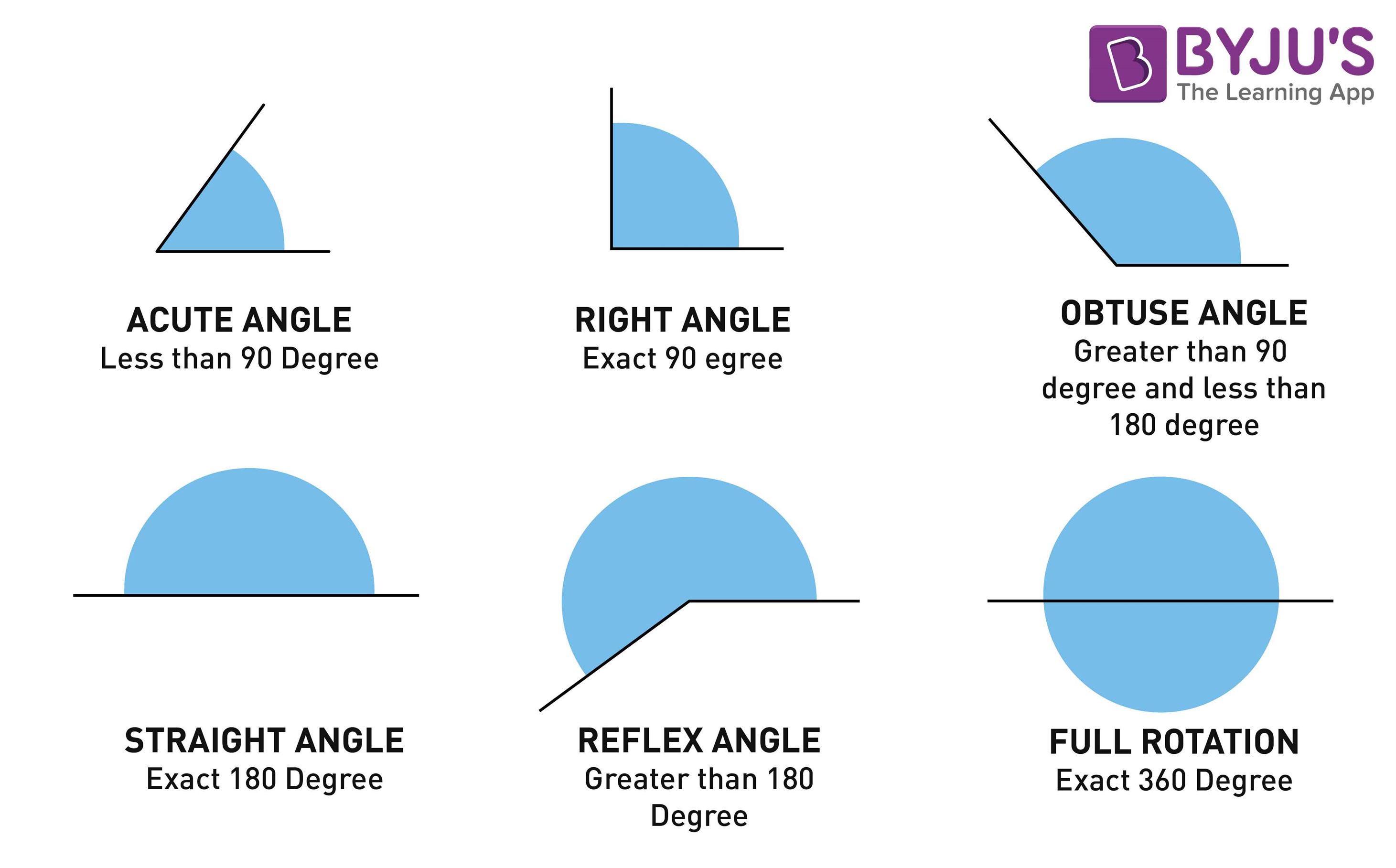More Than 90 Degree Angle
In geometry, in that location are various types of angles, based on measurement. The names of basic angles are Astute angle, Obtuse bending, Right angle, Straight bending, reflex angle and full rotation. An angle is geometrical shape formed by joining two rays at their end-points. An angle is usually measured in degrees.
In that location are various types of angles in geometry. Angles class the core office of the geometry in mathematics. They are the fundamentals that eventually lead to the formation of the more complex geometrical figures and shapes.

Types Of Angles in Geometry
What are Angles
When two rays combine with a mutual endpoint and the angle is formed. The two components of an angle are "sides" and "vertex". The side tin can exist categorized into terminal sides and initial sides (or vertical sides) as shown in the image below.

Representation of an Angle
These 2 rays can combine in multiple fashions to form the different types of angles in mathematics. Allow us brainstorm by studying these different types of angles in geometry.
Parts of Angle
- Vertex – Point where the artillery run into.
- Arms – Ii straight line segments grade a vertex.
- Angle – If a ray is rotated near its endpoint, the mensurate of its rotation is called angle between its initial and terminal position.
For More Information On Parts Of An Angle, Sentry The Below Video:

Classification of Angles
Angles tin exist classified into two primary types:
- Based on Magnitude
- Based on Rotation
Six Types of Angles
In Maths, there are mainly 5 types of angles based on their direction. These five angle types are the most common ones used in geometry. These are:
- Acute Angles
- Obtuse Angles
- Right Angles
- Direct Angles
- Reflex Angles
- Full Rotation

Angle Types Based on Magnitude
The images to a higher place illustrate certain types of angles.
Astute Angle

Acute Angle
An acute angle lies between 0 degree and xc degrees, or in other words; an acute angle is 1 that is less than 90 degrees. The figure in a higher place illustrates an acute angle.
Obtuse Angle

Obtuse Bending
An obtuse angle is the opposite of an acute bending. It is the angle which lies betwixt ninety degrees and 180 degrees or in other words; an obtuse angle is greater than 90 degrees and less than 180 degrees. The effigy above illustrates an obtuse angle.
Right Bending

Right Angle
A right angle is always equal to 90 degrees. Any angle less than 90 degrees is an acute angle whereas whatsoever angle greater than 90 degrees is an obtuse bending. The effigy higher up illustrates a right angle or a 90-degree angle.
Direct Angle

Direct Angle
A straight angle is 180 degrees when measured. The figure in a higher place illustrates a straight angle or a 180-degree angle. You lot tin can meet that it is just a direct line because the angle between its artillery is 180 degrees.
Reflex Angle
Since this measurement is less than 90 degrees, the arms course an acute bending. Merely what about the angle on the other side? What is the larger angle that is complementary to the acute angle called? It is chosen a reflex angle. The image below illustrates a reflex bending.

Reflex Angle
Any angle that has a measure which is greater than 180 degrees only less than 360 degrees (which coincides with 0 degrees) is a reflex angle.
Full Rotation
An bending equal to 360 degrees is called total rotation or full angle. It is formed when one of the arms takes a complete rotation to class an bending.
Angle Types Based on Rotation
Based on the direction of measurement or the management of rotation, angles can be of two types:
- Positive Angles
- Negative Angles
Positive Angles
Positive angles are those angles which are measured in a counterclockwise direction from the base of operations. In most cases, positive angles are used to represent angles in geometry. From the origin, if an angle is fatigued in the (+x, +y) plane, it forms a positive angle.
Negative Angles
Negative angles are those angles which are measured in a clockwise direction from the base. From the origin, if an bending is drawn towards the (x, -y) plane, information technology forms a negative angle.
Pair of Angles
When two angles are paired, and then there be dissimilar angles, such as
Complementary and Supplementary Angles
Autonomously from the aforementioned types, there are 2 more angle types which are complementary angles and supplementary angles. If the sum of 2 angles is equal to 180°, then they are supplementary angles, and if the sum is equal to 90°, so they are chosen complementary angles.
Linear Pair
When the non-mutual arms of adjacent angles are just opposite to each other, or they extend in the opposite direction, then they are called linear pairs. Past linear it is articulate that they form a straight line.
Next Angles
When 2 angles are connected with one common arm and have one mutual vertex and also the non-common arms are either side of the mutual arm, then they are called adjacent angles.
Vertical Angles
When two lines intersect each other at a single indicate (called vertex), then the angle formed on either side of the mutual vertex is called vertical angles or vertically opposite angles.
Angles Formed By Transversal
A line that cuts or intersects two or more lines at dissimilar points, is called a transversal. Information technology is therefore, there are angles formed at the point of intersection. They are:
Video Lesson on Types of Angles

Frequently Asked Questions – FAQs
What are the six dissimilar angles in geometry based on measurement?
The six unlike angles in geometry based on magnitude are:
Acute bending, Obtuse bending, Correct angle, Straight angle, Reflex angle and full angle
What is an acute angle in geometry? Give examples.
The bending that measures less than xc degrees is called acute angle.
Examples: 30°, 45°, 60°, 85° are astute angles.
What is birdbrained angle? Give an case.
The angle that measures greater than 90 degrees is obtuse. For example, 145° is an birdbrained angle.
What is reflex angle?Give an example.
Reflex bending is an angle that measures more than 180° and is less than 360°. For case, 270° is a reflex angle.
What do you mean by nothing bending?
When both the artillery of an angle overlap each other and mensurate the bending of 0°, then it is called the zero angle.
Is obtuse angle and reflex angle same?
Obtuse bending is dissimilar from reflex angle because birdbrained lies betwixt 90 degrees and 180 degrees just reflex is alway more 180 degrees.
More Than 90 Degree Angle,
Source: https://byjus.com/maths/types-of-angles/
Posted by: hallashery1962.blogspot.com


0 Response to "More Than 90 Degree Angle"
Post a Comment